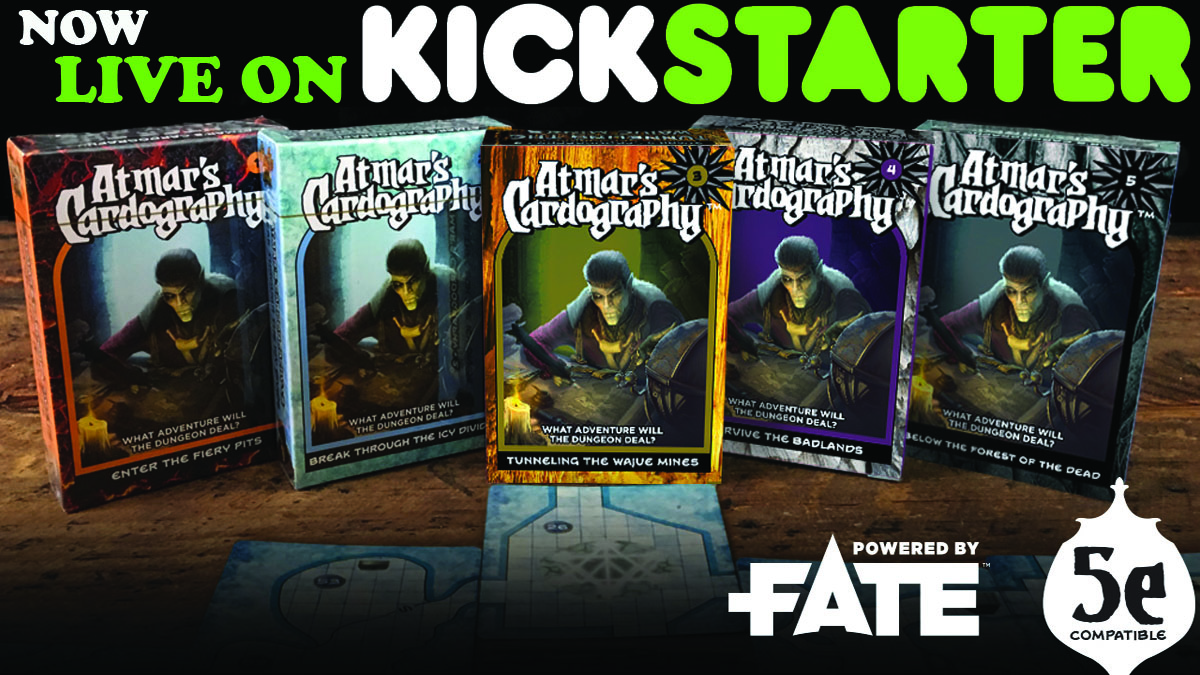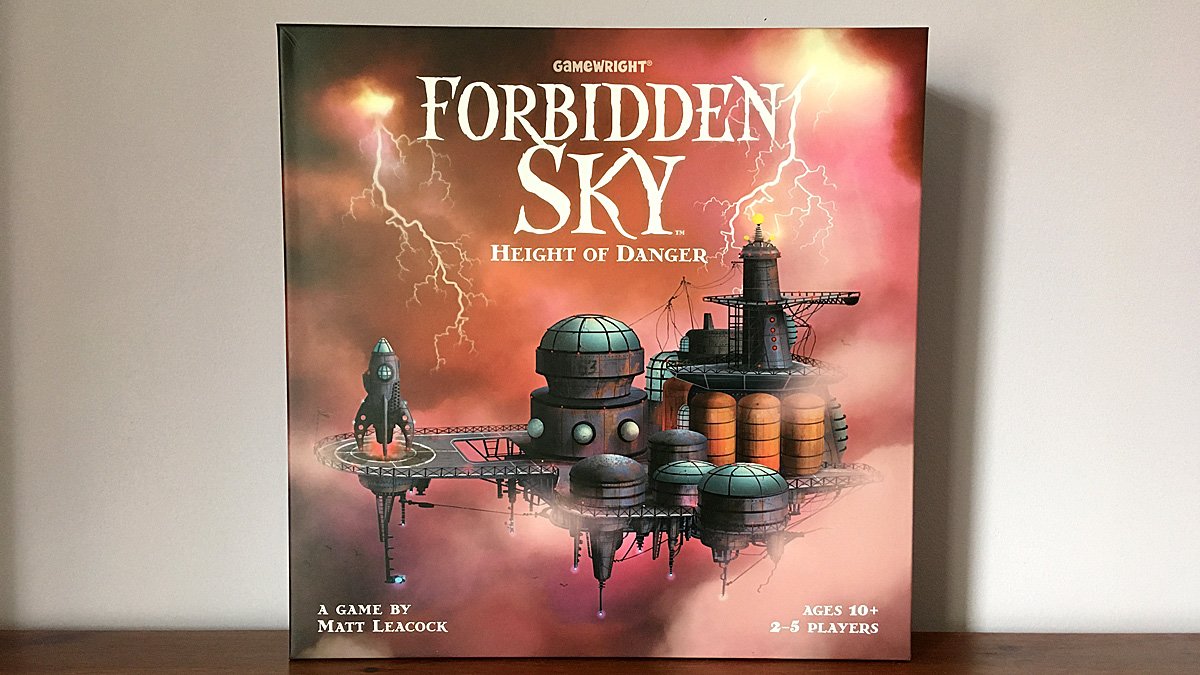
What Is Forbidden Sky?
Forbidden Sky is a cooperative tabletop game from Matt Leacock. In Forbidden Sky, players work together to power up a rocket on a secret power platform floating 7000 feet above the ground. They must connect together capacitors, lightning rods, and a launchpad while avoiding being struck by lightning storms or blown from the platform by the fierce storm raging all around. The game was the judge’s choice winner of the Best American-Style Board Game at UK Games Expo 2019. Please note: This post contains affiliate links.
Components
- 15 Storm Cards
- 14 Equipment Cards
- 6 Adventurer Cards
- 2 Blueprint Cards
- 36 Power Platform Tiles
- 16 Wires (12 Short, 4 Long)
- 6 Lightning Rods
- 6 Small Capacitors
- 3 Large Capacitors
- 1 Launchpad
- 13 Meter Clips
- 6 Wooden Player Pawns
- 1 Storm Meter
- I Storm Meter Stand
- 1 Starting Grid
- 1 Rocket
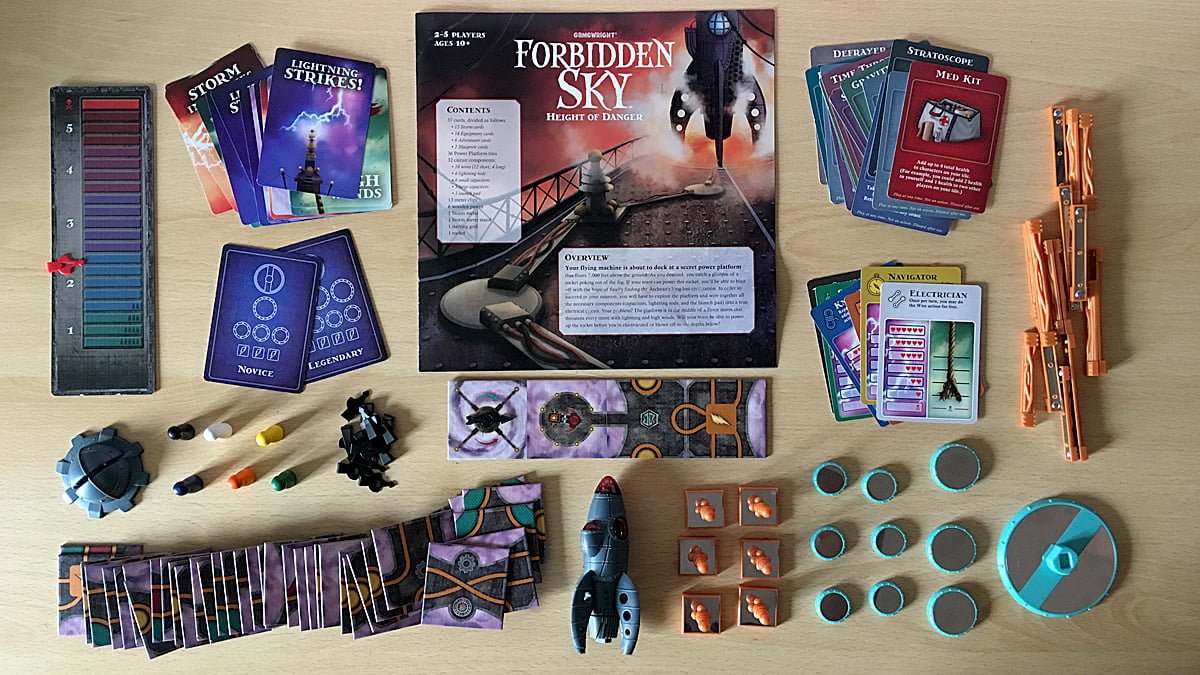
How Do You Play Forbidden Sky?
Setup
Play begins by placing the Starting Grid in the center of the table and placing a Lightning Rod on the indicated space. The 36 Power Platform Tiles are shuffled and placed face down in a stack to form the Power Platform Draw Pile.
The various game components (Rocket, Launchpad, Capacitors, Lightning Rods, and Wires) are placed in groups near the Starting Grid and the Storm Meter is placed into its stand and set up nearby with the read clip pointing at the mark that indicates the number of players in this game.
The cards are divided into separate decks by type. The Storm Cards and Equipment Cards are shuffled and placed into two stacks on the table.
The Blueprint Cards allow players to choose their difficulty level from Novice, Normal, Elite, and Legendary. The instructions suggest beginning on Novice if this is your first cooperative game, and Normal if you have played other cooperative games before – I would disagree and suggest that all players begin on Novice. Each Blueprint Card shows the number of different components required to complete the circuit and win the game.
The Novice Blueprint requires:
- Launchpad
- One Large Capacitor
- Three Small Capacitors
- Three Lightning Rods
While the Legendary Blueprint requires:
- Launchpad
- Three Large Capacitors
- Four Small Capacitors
- Four Lightning Rods

Finally, shuffle the six Adventurer Cards and deal one to each player. Each player should read about their Adventurer’s special skill and share it with the others. Each of the six Adventurers has a unique skill which can be used to help the team and these skills can impact how each player uses their actions during their turn.
- Medic: Heal any player, including themselves, on the same or an adjacent tile for one point of health per action (max of four per turn).
- Navigator: Move another player’s pawn (with permission) up to three tiles per action, including teleporters.
- Electrician: May perform the Wire action for free once per turn.
- Climber: May take one other player’s pawn with them when they move. May also jump over clouds between adjacent tiles, including when blown by the wind.
- Surveyor: Give tiles to other players on the same tile for free at any time. May also hold four tiles at any time instead of three, and begins the game with an extra tile.
- Knotsmith: Repair any player’s rope, including their own, who is on the same tile for one point of wear per action.
Two clips are then added to each Adventurer Card (one at the top of the Health Meter, one at the top of the Rope Meter) and the matching color pawn is added to the Landing Pad on the Starting Grid. Finally, one Power Platform Tile is handed to each player, two to the Surveyor.
Forbidden Sky is now ready to play.
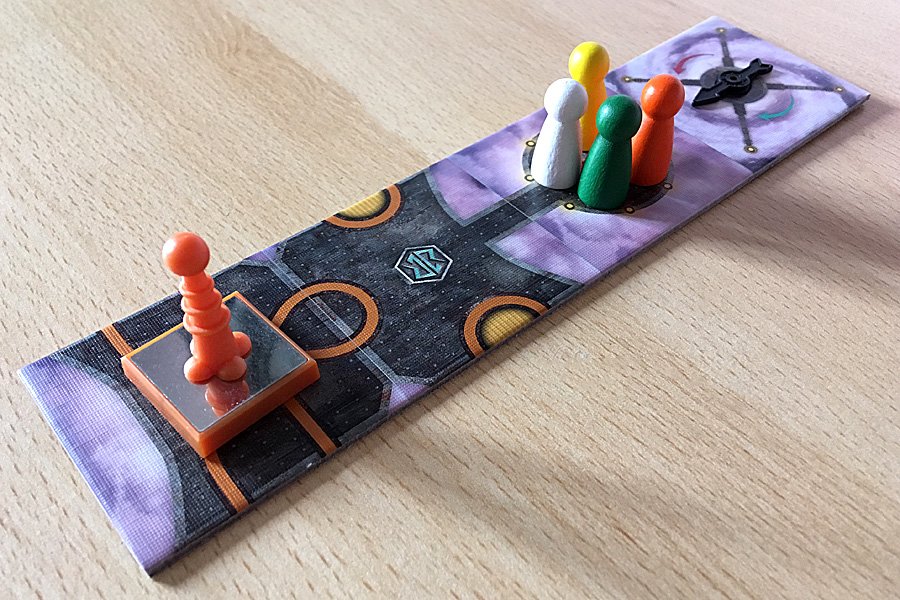
Gameplay
A game of Forbidden Sky is played in turns made up of two steps. On each player’s turn, they:
- Take up to four actions
- Draw and resolve Storm Cards
There are four different actions that each player can take on their turns, and they may take from zero to four of them, in any combination and any order. Each Adventurer can also choose to utilize their special skill during this time.
1. Move
Move your pawn up, down, or sideways (never diagonally) one tile per action. Movement can only occur across connected areas of the platform, not across gaps where you can see the sky. If your pawn is on a teleport symbol, it may move to any other tile with a teleport symbol for one action.
2. Scout
Take the top tile from the Power Platform draw pile. Players may only hold three tiles (four for the Surveyor) so this action may not be taken by a player who already has three Power Platform tiles in front of them.
3. Explore
Place a Power Platform Tile from your hand onto the Power Platform in any position adjacent to the tile your pawn is standing on. It may be rotated in any way, however, at least one printed copper wire on the new tile must connect to a printed copper wire on the current tile. It must also be placed so it squares up with all current tiles.
If the newly placed tile has a lightning rod symbol on it or completes a capacitor circle, that component should immediately be placed down on the tiles.

The photo above shows the different types of symbols on the various Power Platform Tiles.
Top Row (L-R): Tile with Faraday Cage and Equipment Symbols, Tile with Teleport Symbol, Tile with Equipment Symbol, Tile with Wind Shelter Symbol, Tile for Lightning Rod Component.
Bottom Row (L-R): Four tiles make up the Launchpad Circle, Two tiles make up a Small Capacitor Circle, Four Tiles make up a Large Capacitor Circle
Placing a card with an Equipment symbol on it allows the player to draw a card from the Equipment Deck. Placing a tile with the other symbols on it allows all players to make use of that feature with immediate effect.
- Faraday Cages protect all players on that tile from Lightning Strikes effects.
- Wind Shelters protect all players on that tile from High Winds effects.
- Teleporters allow players on that tile to move to any other tile containing that symbol for one action.
4. Wire
Add or remove a physical wire piece to a component on your current tile. Components may have up to two wires connecting to them with a clean connection to the metal. Attaching the final wire to complete the circuit will launch the rocket, so you must make sure that all player pawns are on the four launchpad tiles before this is placed or someone will be left behind and you will lose the game.
In addition to the four actions, players on the same tile may also share equipment cards at any time.
Equipment Cards
There are ten different types of equipment cards. For the majority of these, there is only one card of each type but there are three Jet Pack cards, two Strike Shields, and two Gravity Hooks. Equipment cards can be played at any time and do not count as actions.

- Med Kit (1) – Add up to four health points across to characters on your tile including yourself.
- Jet Pack (3) – Move to any tile on the platform, you may take another pawn currently on your tile with you.
- Stratoscope (1) – Draw up to five platform tiles, keep one and place the others face down at the bottom of the draw pile.
- Defrayer (1) – Add up to four rope repair points across to characters on your tile including yourself.
- Time Throttle (1) – Take three additional actions during your turn.
- Strike Shield (2) – Protects you and any other players on your tile from lightning strikes until the beginning of your next turn.
- Aerometer (1) – Take up to six cards from the top of the storm deck, look at them and return them in the order of your choice.
- Platform Clamp (1) – Place a tile held by any player adjacent to your current tile.
- Gravity Hook (2) – Protects you and any other players on your tile from high winds until the beginning of your next turn.
- Remote Fuser (1) – Add or remove any wire between any two components on the platform.
Storm Cards
After a player has taken their actions, they draw Storm Cards from the deck. The number of Storm Cards the player draws is equal to the current Storm Intensity Level. The cards are drawn and resolved one at a time and there are four different card types that can be drawn.

Lightning Strikes! (Six Cards)
Every Lightning Rod in play is struck by lightning and every player on a lightning rod tile or one connected to it by a wire (either printed or laid by the players) is jolted. Players who are jolted lose one health point unless protected by their equipment and the clip on the health track of their Adventurer Card moves down one level. If the clip reaches the skull symbol at the bottom, they die and everyone loses the game.
High Winds (Four Cards)
The wind suddenly blows and all players are blown one space in the direction currently shown on the Wind Compass. If a player cannot move onto another tile in that direction, or if there is a gap in the platform where you can see clouds, their rope is worn down by one point and their clip moves down one level on their Adventurer Card. If the clip reaches the skull symbol at the bottom, they fall and everyone loses the game.
Winds Change (Two Cards)
The arrow on the Wind Compass moves 90 degrees clockwise or counterclockwise depending on which card is drawn.
Storm Intensifies (Three Cards)
The clip on the Storm Meter moves up one level. If it reaches the skull symbol, the storm is now so intense that everyone is blown from the platform and dies, and the game is lost.
One of the three Storm Intensifies Cards has additional rules. If this card is drawn, the entire Storm Deck is reshuffled and no more cards are drawn this turn.
Winning and Losing the Game
There is only one way to win Forbidden Sky and four ways to lose!
In order to win, all the components of your chosen blueprint must be placed onto the board and wired together except for one final wire. All the player pawns must be standing on one of the four Rocket Pad tiles when the final wire is placed and the rocket launches taking everyone to safety.
To lose the game:
- Electrocuted: Any player’s health clip reaches the skull symbol.
- Fall: Any player’s rope meter reaches the skull symbol.
- Swept Away: The clip on the Storm Meter reaches the skull symbol.
- Abandoned: A player is left behind when the rocket launches without all the player pawns on a launchpad tile.
Should You Buy Forbidden Sky?
We own all of the Forbidden games and Forbidden Sky has easily been our least favorite. While Forbidden Island and (admittedly to a slightly lesser degree) Forbidden Desert were elegant in their simplicity, Forbidden Sky has ditched that to become overly complex. While not a complicated game in the grand scheme of things, the thing that always drew me into Island and Desert was how balanced the games felt. They are never easy to win, but you always feel as though the odds are fair. That is what is missing from Forbidden Sky, a game where every decision feels weighted against you from the minute you begin to play.
All that being said, this is not a “bad” game. Far from it. There’s a real feeling of pressure on every choice which means that every decision is poured over and carefully discussed by the whole team before any actions are taken. That’s something you don’t get with the other two Forbidden games because, in those, there usually feels like there’s the opportunity to recover from mistakes, whereas here, one misstep will almost certainly be your undoing. The experiences I’ve had playing Forbidden Sky with groups of two, three and five players have been incredibly intense, but I’m not sure I would label them as also being fun.
There’s a lot to love in the game design too. The concept of using metal pieces to literally wire up your rocket as you play is unique and adds a really fun element to the game. The design of the board and the pieces has an almost Steampunk aesthetic and I found myself reminded heavily of Discoveryland in Disneyland Paris – itself inspired by the works of Jules Verne. Every piece feels well thought out and designed to belong in the world of the game, except perhaps for the character tokens which are standard, colored wooden playing pieces.
Forbidden Sky will work well for groups looking to take a (very big) next step up from Forbidden Desert. The mechanics are comparable, so there aren’t too many entirely new concepts to learn, but there’s also enough new in there to make the game different from its predecessors. This definitely isn’t Island or Desert with a new skin.
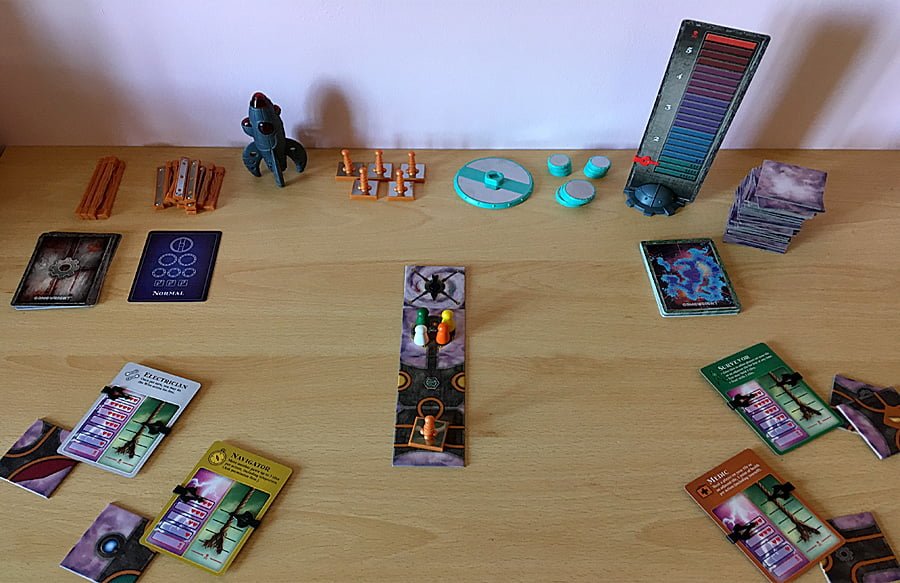
However, in my opinion, Forbidden Sky is likely to be picked up by families who have enjoyed the previous two games in the series and are looking to add something new in a similar vein to their collections. For these players, the huge step up in complexity may be too big a jump and could well come as a huge shock to those casual gamer families. We have played many games of Forbidden Sky and have yet to even come close to winning, despite being able to win the other games in the series with relative ease. I also can’t help but think that if you’re actively wanting to play a game at this level of complexity, there are better games out there, Pandemic being an obvious and immediate example.
Forbidden Sky isn’t a bad game but I feel that it struggles to know who to market itself to. Is it a family coop game in the same style as its two predecessors or something more complex aimed at gamers looking for more intense strategy? It doesn’t quite fit into either box and I fear this could be its downfall in the long run.
GeekMom received a copy of this game for review purposes.


